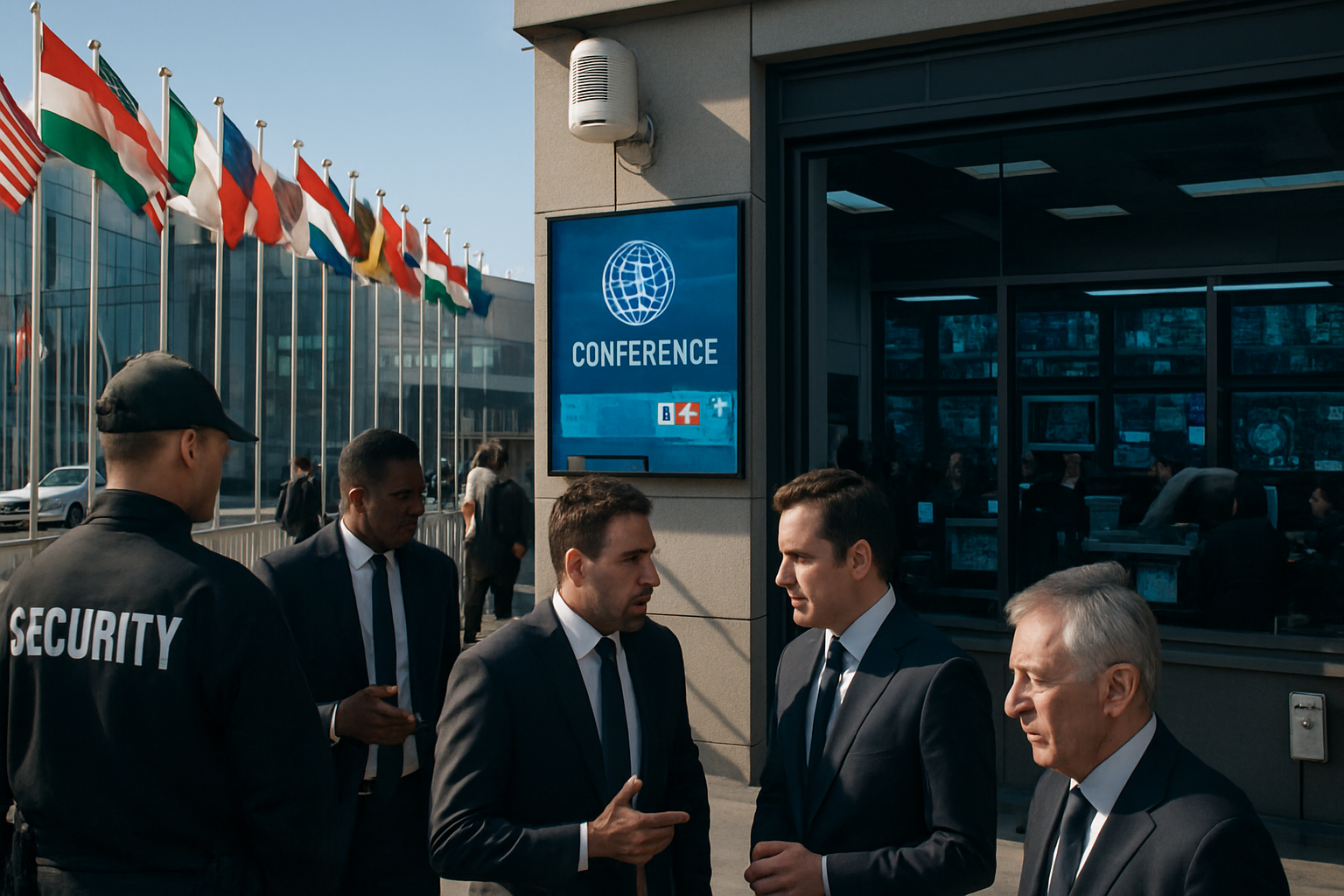This article first appeared on www.hstoday.us.
In 2026, the United States will host several high-profile global events, attracting numerous prominent business, financial, and political leaders from around the world. These dignitaries will converge in the U.S. to discuss and coordinate policies on significant global challenges, including the economy, climate change, sustainable development, and peace. The events hosting these dignitaries pose a potential homeland security threat to the United States and its guests, and a tempting target for those seeking to sow chaos, discontent, or even global conflict.
Some of the events on America’s calendar include the 81st Session of the UN General Assembly in September, the Global Leadership Summit in August, the G20 Leaders’ Summit in November, and more. Additionally, the White House will be hosting America 250, celebrating the 250th anniversary of the United States, starting in May and culminating on July 4, 2026.
Events of this magnitude and intergovernmental importance present strategic opportunities for adversaries looking to negatively impact the host nation or potentially disrupt global order. A successful attack on American soil during these gatherings would carry significant geopolitical repercussions, impacting alliances and shaping the future of international diplomacy.
Federal and local law enforcement agencies will be responsible for providing security at these events. While homeland security teams primarily focus on traditional attack methods like firearms or explosives, they can’t ignore the possibility of a chemical attack, however slight the chance of this attack methodology being implemented.
The World Economic Forum’s Global Risks Report 2025 describes the risks the world faces over the next two years, as well as an outlook for the next decade, as “bleak.” Specifically, the risk of “biological, chemical, or nuclear hazards” saw a sharp rise in the risk rankings, jumping eight positions from the previous year in the two-year forecast. The same risks rise by four additional positions in the 10-year outlook.
Therefore, while kinetic threats remain the most probable form of attack, the possibility of a chemical attack represents a critical, often underestimated risk that must be addressed as part of comprehensive high-profile event risk management, particularly when diplomats and the world’s leading business and finance decision makers are involved.
Attack motivators
In 2025, the world experienced significant political and social turmoil, and the United States, due to its global importance, was involved in many regional issues. Additionally, with the push for a ‘bipolar world’, businesses and financial organizations that are viewed as favoring a particular side could be seen as a valid target. Attacks on important economic, political, and business events held in the homeland in 2026 could therefore be a tempting target for domestic and foreign groups, or their proxies, as well as lone-wolf attackers.
Complicating matters further, third parties may launch attacks designed to appear as if they originated from another country, thereby discrediting that country and disrupting diplomatic or economic cooperation. If a chemical attack were blamed on any foreign entity, the risk of retaliatory actions cascading into diplomatic actions including sanctions, and military activity is a real possibility.
Additionally, the risk of domestic extremist organizations carrying out attacks represents another significant threat to homeland security, especially with the current tensions in some cities across the country. Once again, targeting important events will intensify uncertainty and could cause some entities to reconsider their US investment or partnership decisions.
Detection challenges
As noted, law enforcement mainly targets traditional weapons and explosive threats, including potential car ramming and drone-based attacks. However, over the past few years, the trend in chemical attacks has shifted to agents that cause choking, such as chlorine and related chemicals, or vesicant agents (those that cause blistering), which is another risk to the homeland and VIP guests.
The persistence of the chemical on the ground or in the air is also a determining factor in the number of casualties. A short period before the agent becomes inert means there will be sudden casualties, but the threat will soon pass. On the other hand, persistent agents can remain dangerous for longer, meaning the risk is extended and the danger zone may expand. These facts make it critical for security and medical personnel to have the capability to quickly identify the agent in order to quarantine dangerous areas and assist victims. Once they know what they are dealing with, they can act with confidence.
The selection of potential agents is lengthy, but the first group to identify is chemical warfare agents, such as Novichok or VX. These agents are made to cause mass casualties and are the most dangerous. However, producing these chemicals requires a professional team, as they cannot be manufactured in somebody’s basement. This reduces the likelihood of their use in an attack, but does not eliminate it.
On the other hand, the possible use of ‘home-made’ chemicals should still be taken seriously, as perpetrators can produce deadly toxins without access to a professional laboratory. Deployed effectively, they are just as harmful.
There is also the risk that attackers could lace inert gases with illicit drugs, such as fentanyl, which they can disperse in closed areas. However, unless the perpetrators have a very good dispersal mechanism, these are unlikely to cause mass casualties, but can harm some people and create panic in an environment where VIPs are congregating. Admittedly, this is a highly unlikely scenario.
The problem with chemical agents is that there are no telltale signs security operators can look for. To counter conventional weapons and explosives, metal detectors, X-ray scanning, and canines can be used with a reasonable expectation of preventing weapons from entering a restricted facility by homeland security teams. Chemicals, however, can be kept in any container, and if stored correctly, can pass through almost any kind of scanner and will only be detected when released. Some highly toxic agents are fatal in very small amounts require and can be concealed in innocuous-looking containers, which makes early detection critical.
The primary early warning system for chemical attacks is a network of gas sensors located at various points within the location that continuously sample the air and raise an alert if something suspicious is detected. Naturally, monitoring the HVAC (heating, ventilation, and air conditioning) system is always a key component of risk management in secured locations.
Preparation starts well in advance
For the homeland security sector, securing a high-profile event starts long before the dignitaries arrive. Law enforcement officers, for example, make plans to divert traffic from restricted routes and prepare emergency responses to potential security breaches or protests. Similarly, air traffic over the area will be banned, and the skies will be monitored for planes or drones breaching the perimeter.
One of the critical foundations of preparation is a command-and-control center. The command center is not only a place where security centralizes its efforts, consolidates information, and manages the security of the event, but also serves as a coordination and communications hub. It serves as an epicenter of collaboration, where public and private operations share and receive information on the status of security operations in real-time. The command center must therefore be an advanced, open, and unified system capable of collecting information from a wide variety of sources, ranging from gas sensors to 2-way radio communications and cellular data.
The ability for the command-and-control center to receive, analyze, and implement actionable information is crucial. Typically, this data and insights will be provided by various government, military, and law enforcement intelligence entities and obtained from open-source, human, and signal intelligence sources.
Foreign dignitaries will all arrive with their own security teams and protocols, and these must be integrated into the command center, as must their emergency protocols. There is no place for playing favorites, and every authorized person at the event must be connected and informed.
Additionally, a large-scale event will require a substantial security contingent, including local and federal law enforcement officers, as well as private security operators if required. Private operators, often hired on a contract basis for specific events, must undergo thorough background screening and possess the necessary skills to perform their roles effectively. Screening is essential, as many will be connected to the command center and have access to sensitive information. They also pose a risk if they secretly belong to extremist groups or have links to suspect people or organizations that might influence them to take part in an attack or turn a blind eye.
Moreover, in the event of an emergency, foreign embassies and consulates will overwhelm the State Department’s phone lines, demanding answers. The command center must therefore be in constant communication with the State Department, not necessarily for the running of the event’s security, but to receive real-time updates and the latest information to inform and assist in evacuating the scene and ensuring foreign delegates can reach an airport to fly their VIPs home quickly.
Critical elements of preparation
Training and rehearsals for all personnel involved are essential. Additionally, preparation begins with intelligence gathering from all available sources, including national intelligence agencies, law enforcement, and, increasingly, open source intelligence obtained from social media and dark web analysis. All relevant information must be collated, analyzed, and monitored in real-time from the command center. Cooperation and sharing of actionable information with foreign intelligence services is also essential.
The center must also monitor wind patterns to ensure escape routes are safe and evacuees and first responders are not surprised by unexpected changes in wind direction that result in chemical agents blowing into supposedly secure areas.
Just as security personnel must be thoroughly vetted, the event location also requires a thorough background survey before the event to understand what ‘normal’ is. This includes testing the air multiple times before the event setup begins and before it starts to establish a baseline. Sensors, whether manually operated or installed in common areas, should then be used to sample air throughout the event. If a chemical attack occurs, security can quickly identify changes in the air composition and activate emergency protocols.
The availability of presumptive analysis devices that can accurately and rapidly identify thousands of suspicious compounds in the field is not optional. They must therefore be used proactively at all points of access and egress to identify suspicious liquids being carried into the event. In addition, in the event of an attack, they can quickly identify the deployed chemical agent and share the information to help first responders take the appropriate action.
All the information, collated and analyzed in the preparatory stages, transforms the unknown into the known, enabling security teams to prepare for chemical agent attacks by stocking sufficient personal protective equipment (PPE), understanding response and recovery requirements, and determining the critical lines that separate people from areas restricted to first responders, and another line demarcating an area of high risk. The preparation is, naturally, not limited to chemical attacks, but to any potential aggression.
Additionally, while the primary objective will initially be to save lives and secure the area, the investigative component of the security operation must begin as soon as possible. Collecting evidence and establishing a chain of custody, as far as is possible amid the chaos, is challenging but not optional. The investigation will inform potential criminal proceedings following the attack, and every country present will want to independently verify the lab results and confirm the collected evidence for their own investigations.
While the likelihood of a chemical attack, as mentioned, is slim, a successful chemical agent attack in the United States would have financial, economic, political, reputational, and social ramifications that remain top of mind for years. Ultimately, meticulous preparation, timely communication, and coordinated responses are essential to ensure the safety of all attendees and the success of these high-profile events.
Views expressed in this article are the opinions of the author, and do not necessarily reflect the views of Rigaku Analytical Devices.



